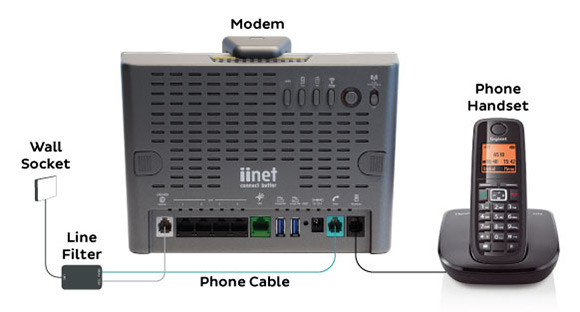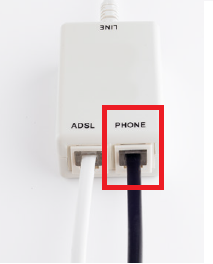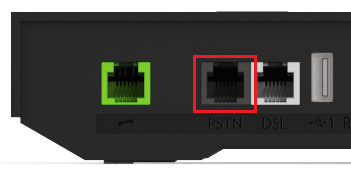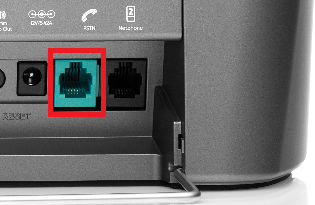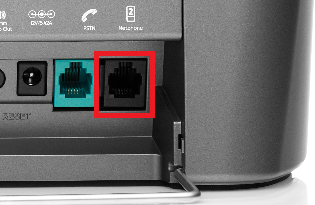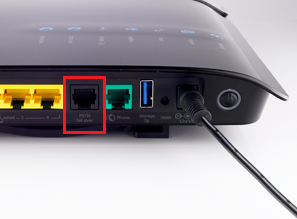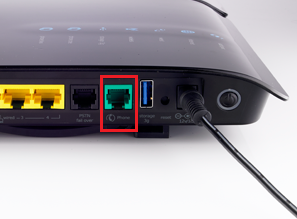Netphone PSTN Failover on iiNet Modems
Please note that only the following iiNet modems support PSTN Failover: TG-1 Broadband Gateway, Budii, Budii Lite, BoB2 & BoB Lite.
Select one of the links below to jump to a query:
- What is PSTN Failover?
- What you’ll need
- Select your modem:
- PSTN Failover on TG-1 Broadband Gateway
- PSTN Failover on Budii Lite or Budii
- PSTN Failover on BoB2 or BoB Lite
What is PSTN Failover?
"PSTN Failover" is a way of plugging in your modem and handset so it can make and receive both Home Phone (landline) and VoIP (Voice over Internet Protocol) calls.
- By default, outgoing calls will be made using your Netphone (VoIP) service.
- In the event that your broadband or VoIP service is down, outgoing calls will be made using your Home Phone service - if this is the case, before you dial a number you'll hear an alert through the handset speaker that Home Phone rates will apply to the call.
- You can force a call to be made using your Home Phone service instead of the VoIP service by dialling ** before the phone number.
To set up, all you need to do is to make sure the PHONE side of your line filter/splitter is connected to the special PSTN failover port on your modem. Please see the specific instructions we've prepared for our modems below.
What you’ll need
Before you get started, make sure you've followed your modem's setup guide to set up your VoIP service.
Hardware
- A modem that supports PSTN failover
- An additional phone handset to plug into your modem. Some modems may include a handset you can use (i.e. Budii, BoB2)
- A standard RJ11 phone cable
- An ADSL/ADSL2+ filter/splitter
Services
- An ADSL/ADSL2+ broadband service
- A Home Phone service
- A VoIP service
Select your modem:
| TG-1 Broadband Gateway | |
| BoB2 or BoB Lite |
PSTN Failover on TG-1 Broadband Gateway
- If you haven’t already done so, make sure your modem is plugged into the ADSL port of a line filter, and the line filter is plugged into your telephony wall socket.
- For PSTN failover to work, there must be a standard RJ11 phone cable connected to the PHONE port on your line filter, and the black PSTN port on the back of your modem.
- Plug a standard phone handset into the green Phone port on the back of the modem to finish.
PSTN Failover on Budii Lite or Budii
- If you haven’t already done so, make sure your Budii/Budii Lite is plugged into the ADSL port of a line filter, and the line filter is plugged into your telephony wall socket.
- For PSTN failover to work, there must be a standard RJ11 phone cable connected to the PHONE port on your line filter, and the green PSTN port on the back of Budii/Budii Lite.
- Budii: you can use your Budii handset to make and receive calls. Alternatively, you can plug a standard phone handset into the black Netphone port on the back of Budii.
Budii Lite: you’ll need to plug a standard phone handset into the black Netphone port on the back of Budii Lite.
PSTN Failover on BoB2 or BoB Lite
- If you haven’t already done so, make sure your BoB2/BoB Lite is plugged into the ADSL port of a line filter, and the line filter is plugged into your telephony wall socket.
- For PSTN fail over to work, there must be a standard RJ11 phone cable connected to the PHONE port on your line filter, and the black PSTN failover port on the side of BoB2/BoB Lite.
-
BoB2: you can use your BoB2 handset to make and receive calls. Alternatively, you can plug a standard phone handset into the green Phone port on the side of BoB2.
BoB Lite: you’ll need to plug a standard phone handset into the green Phone port on the side of BoB Lite.
